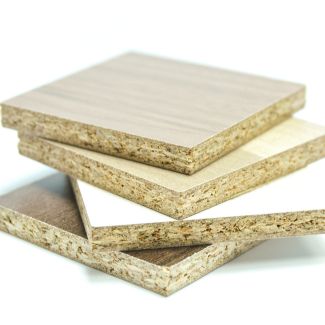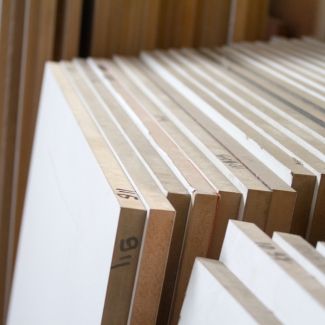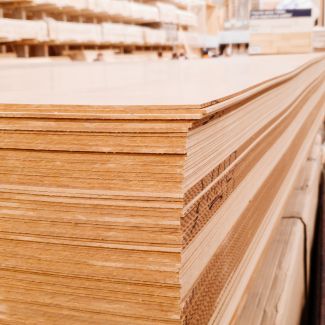Table of Contents
Quality Service Guarantee Or Painting Free

Get a rental agreement with doorstep delivery

Find the BEST deals and get unbelievable DISCOUNTS directly from builders!

5-Star rated painters, premium paints and services at the BEST PRICES!
Loved what you read? Share it with others!


Submit the Form to Unlock the Best Deals Today
Check Your Eligibility Instantly

Experience The NoBrokerHood Difference!
Set up a demo for the entire community
Engineered Wood: Meaning, Type, Pros and Cons
Table of Contents
The importance of wood in our lives cannot be overstated! Just look around you and you will see wood in different forms, shapes, and types, right from trees that give us shade in this scorching summer, to the bed that we sleep on, wood is the most important material in our daily life!
There are many use cases of wood but interior furniture has to be why most of the wood today is manufactured. With the rapidly growing population, we had to find a way to manage the demand for solid wood. As demand for solid wood rose, and restrictions increased, people discovered a substitute called engineered wood. Today, the technological advancement and growing need for wood have led to many types of engineered wood that are used to satisfy different aspects of interior and external structural furniture.
What is Engineered Wood?
If you have talked to any interior decorator in the past few years, or have shifted into a house which you spent hours decorating, or shopped for interior furniture yourself, the chances of you buying something made of engineered wood are very high! It has become one of the most used materials for residential and commercial furniture design and there are many reasons behind the gradual rise of this type of wood.
Quality Service Guarantee Or Painting Free

Get a rental agreement with doorstep delivery

Find the BEST deals and get unbelievable DISCOUNTS directly from builders!

5-Star rated painters, premium paints and services at the BEST PRICES!

We all know that wood in its natural way comes mainly from different trees but as natural tree cover got depleted, and many environmental regulations became stricter, people started using engineered wood, a slightly different variety that is a replacement for solid wood and is mainly made by binding together different particles and strands with the help of adhesives.
What is Engineered Wood Mostly Made of?
The name engineered wood meaning indicates that the wood is artificially created as opposed to occurring naturally in nature. The main materials that make up this type of wood still consist of the same soft and hardwood that is used in the manufacturing of lumber. As we will see some major types of engineered wood later on in the blog, you will realize that some engineered wood materials are also made from wood waste such as leftover sawmill scraps that are good enough to bind together using adhesives and other fixation methods that make up composite materials.
Essentially, the topmost layer of the engineered wood is made to look the most beautiful, with a typical veneer made of solid wood. This is the layer that we need to touch and feel when choosing the engineered wood. Note that solid woods can come from any kind of two varieties including hardwoods like oak, maple, and walnut, and softwoods such as fir, cedar, or pine. Hardwoods are more expensive than softwoods as they take longer to grow, are more durable, as well as require less maintenance. The second layer of the engineered wood is generally made to be a strong one so that it can support the ply of wood made up of MDF (medium-density fibreboard) or particle boards. This layer is crucial in keeping the top layer from bending or buckling under pressure. The final layer is called the back layer, which also serves as a stabilizing layer for the rest of the two layers so that they don’t bend under stress.
This means that the solid hardwood as a complete layer is more durable, rather than engineered hardwoods. This is because complete solid hardwood can be refined and sanded down more times than engineered hardwood before it is exhausted. This also means that the engineering wood price will be lower than solid hardwood.
What are the Different Types of Engineering Wood?
We all know that there are many types of solid wood, depending on the type of tree that the wood comes from. Similarly, there are multiple types of engineering wood, and they all serve different use cases and have different benefits. Understanding these various types will be hugely beneficial if you are planning to decorate your house or wish to help someone with their furniture shopping!
The first step is to understand the difference between traditional wood and modern engineered wood. On one hand, where the traditional wooden option provides a strong, sturdy design apt for Indian homes, the price of wood is very high as compared to modern alternatives. The different types of Engineered wood offer the same qualities offered by traditional wood at a much lesser price point.
What are the Pros and Cons of Engineered Wood?
With the abundance of materials in the market and so many manufacturers, the average consumer can get confused easily. If you are planning a reconstruction in your house or want to add a new piece of furniture, you should consider the following pros and cons of using Engineered wood in your home.
Advantages of Engineered Wood
- A cheap alternative to traditional wooden designs.
- High moisture resistance
- High electrical and thermal resistance.
- Gives the same finish as traditional wood
- Easy to work with and customise as per the requirements.
Disadvantages Of Engineered Wood
- Susceptible to Dents and Scratches
- Weaker core compared to traditional wood
- Requires timely maintenance
- Toxic chemicals are used sometimes
- Prone to wear and tear and fade over time.
Solid Versus Engineered Wood Flooring
It is important to note that other than durability, solid wood flooring tends to come in longer planks than engineered ones. While both look similar, using a combination of both can work wonders for your floors. Regardless, here are some of the key differences you should know about are:
- Engineered wood flooring can last up to 20-30 years while being less expensive than solid wood flooring (which can last from 30 to 100 years).
- You can sand or refine solid hardwood flooring 2-3 times over the floor’s life, while you can only do it once or twice with engineered wood.
- Neither wood types are resistant to heat so must not be installed in heavy-moisture places.
- You should not install solid hardwood flooring against cement slabs as they can resultantly warp, while engineered wood does better on installation against concrete slabs.
1. Plywood

Often known as the “Original” type of engineered wood, Plywood is surely the most popular form of alternative wood that most people in India are aware of! It is used for everything right from bed sets to wardrobes and storage units (especially for commercial spaces) and Ply is mostly made of veneer sheets that are cross-laminated and are bonded together by applying heat and pressure using quality adhesives that are moisture resistant. One of the major advantages of using Plywood is that it is incredibly versatile and can be used for any interior panelling, structural furniture, or even external applications mostly since it is very economical and has incredible commercial value. However, it is not advisable to use Ply as the main material to hold anything too heavy, nor can one use it in humid conditions.
Plywood price: Price depends on the quality of Plywood that you are buying but in most of the markets in India, the price of Ply will range between Rs. 90 per square foot to Rs. 220 per square foot.
2. Blockboard

One of the most popular choices of wood, especially in high-scale urban areas is Blockboard. It is the go-to material if you wish to build doors, storage panels, partitions, and even a house! This is the most preferred type of engineered wood if you are building study tables, dining tables and so on, as the wood is sturdy and made by binding together different core particles and softwood strips. Manufacturers often take thick strips and apply high pressure to make a smooth structure that can be used for any furniture work. The main advantage of using Blockboard is that it is much lighter than ply and is also great for making large indoor furniture such as doors due to the hard, sturdy, quality of the material.
Blockboard price: Blockboard can be bought at a price of Rs. 80 and Rs. 210 in most of the markets in India.
3. Particle Board

Are you someone who cares a lot about the impact of humans on the environment and wants to make an effort in sustainable living? Then you should surely check out the Particleboard when you are thinking of what material to use for your house or office furniture. It is the most eco-friendly type of engineered wood completely made of pressing together wood shavings, sawdust, and other particles that were earlier going to waste but now are recycled to make parts of particle board! Not only is this material much cheaper, but it is also a much more uniform type of wood that one can use as an alternative to solid or Plywood. Unfortunately, due to the slightly low quality of the main components, this type of material often expands and is prone to issues that occur due to humid conditions. Applying a thick coat of paint over the wood is usually enough to ensure that the furniture lasts long.
Particleboard price: Being one of the most eco-friendly wood types, one can obtain particle board at a nominal price of Rs. 20 to Rs. 50 per square foot.
4. Medium-density Fibreboard

Popularly known as MDF, this type of wood is often the most preferred and used for making beautiful office interior furniture or quality kitchen cabinets. Nowadays, many of the top-end apartments, villas, and bungalows have wooden flooring which is made completely from MDF. You can imagine some of the qualities such as its dense structure, and ability to soak water make it a great choice for outdoor furniture items such as carry-on boxes and small storage spaces. Making a Medium-density fibreboard is a long process that starts by breaking hard and softwood into smaller pieces and then using resin and wax to bind the smaller particles together to make large structures. A big advantage of using this as your primary wood material is that it has a very smooth finish (thanks to the resin being used) and is also perfect for outdoor furniture.
MDF Price: This is a relatively pocket-friendly material that one can buy for Rs. 45 per square foot to Rs. 190 per square foot.
5. High-density Fiberboard

High-density fiberboard or HDF as it is popularly known in the market is another form of engineered wood that is made primarily from pulped wood waste and chips. HDF is a very durable type of engineered wood made by adding oil to produce the polymer and a large smooth structure. It is a much denser material and thus it is a great option if you want to install long-lasting wooden flooring in your house or office. Because the material is good at absorbing water, it is not advisable to use HDF on the exterior floor but the material is sturdy and good for interior flooring that gives a glossy finish.
HDF price: The average price of HDF wood in the Indian market ranges from Rs. 50 per square foot to Rs. 170 square feet as per the current engineered wood price per sq ft rates
6. Laminated Veneer Lumber

Laminated Venner is a special type of engineered wood that is generally used for forming the rim boards, beams and other materials used to cascade the edges of the bed. In this form of engineered wood, multiple thin layers of wood sheets are bonded together with adhesive. The structure is given uniformity through the thin sheets and it's very lightweight in nature.
Laminated Veneer Lumber Price: The price of laminated Venner Sheets in the Indian markets starts at Rs.150/square foot.
7. Cross Laminated Timber (CLT)

Cross-Laminated Timber or CLT is a plank of engineered wood where the sheets of the wood are glued at perpendicular angles giving the entire structure a criss-cross architecture. CLT is known for its strength and durability and has emerged as an exceptional alternative to traditional wooded designs.
Engineered wood is one of the most popular and widely used alternatives to solid wood that is being used all over the world today. It has different types and can be used to make indoor furniture such as kitchen cabinets, dining tables, doors, and flooring and is an eco-friendly substitute for solid wood. If you are confused about the interior decoration of your house or office then you can easily consult experts at NoBroker who are available round-the-clock to help you with everything from finding your new home to decorating it!

Frequently Asked Questions (FAQs)
Ans. The main difference between the two is that solid wood is mainly made from entire logs of wood directly cut from the trees. Whereas, engineered wood is mostly made from scraps and wood leftover particles, sawmill scraps, and it is put together with the help of binding agents such as moisture-proof adhesives.
Ans. You can find 7 popular types of engineered wood available in the market. There are new types being introduced every day, so this number is likely to keep changing.
Ans. Plywood is a preferred material for commercial and residential furniture and hence the demand for Ply is always high. The average price of the material in tier 2 and tier 3 cities in India is Rs. 90 per square foot while in urban cities the cost may range from Rs. 120 to 230 per square foot.
Ans. It is well-known that if you want to shop for material for doors, dining tables, and study tables, blockboard is the best type of wood you can go for! Surprisingly, the blockboard price is similar to that of Ply, despite being more studier than traditional engineered wood types such as Ply.
Ans. Particle wood which is made from mostly scraps, wood shavings, and sawdust is widely considered as one of the most eco-friendly materials of wood. Apart from being environment friendly, the material is also cheap, starting at Rs. 20 per square foot.
Ans. While there is no clear answer to this, the most preferred wood for wooden flooring is Medium-density fibreboard (MDF) or High-density fiberboard (HDF) which can be bought from the market for an average price of Rs. 80 per square foot.
Recommended Reading

Best House Floor Design Ideas in 2025 for Every Room in Your Home!
January 31, 2025
5906+ views

Top Marble Flooring Design Ideas in 2025
January 31, 2025
4969+ views

Bathroom Floor Tiles Design: Your 2025 Guide to Choices & Trends
January 31, 2025
3539+ views

Modern Marble Floor Border Designs to Get Inspired From
January 31, 2025
3476+ views

Floor Carpet Designs for Living Room: Interior Decor More Stylish
January 31, 2025
3028+ views
Loved what you read? Share it with others!
NoBroker Interiors Design Testimonials
Most Viewed Articles

Top Hanging Light Ideas to Illuminate Your House
January 31, 2025
393844+ views

GFRG Panels - A New Technology in Building Construction
January 31, 2025
258461+ views

15 Wall-Mounted Dining Table Design Ideas
January 31, 2025
104274+ views

How Mivan Construction Technology Is Transforming the Art of Building!
January 31, 2025
75431+ views

Best 3 Bedroom House Plan: Modern and Space-Efficient Layouts for 2025
January 31, 2025
43688+ views
Recent blogs in
Luxury Bedroom Interior Design: Transform Your Space with Elegance in 2025
February 19, 2025 by Simon Ghosh
February 14, 2025 by Rahul Sahani
30 Best Living Room Modern Interior Design Ideas for Your Modern Living Space 2025
February 7, 2025 by Priyanka Saha





Join the conversation!